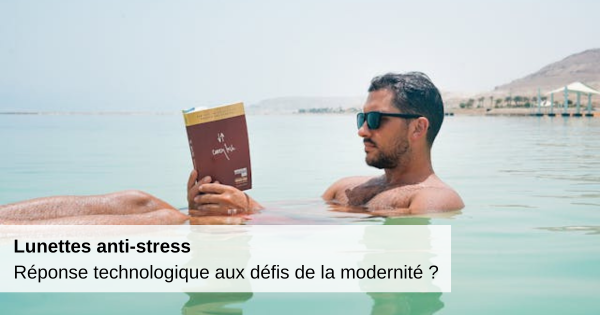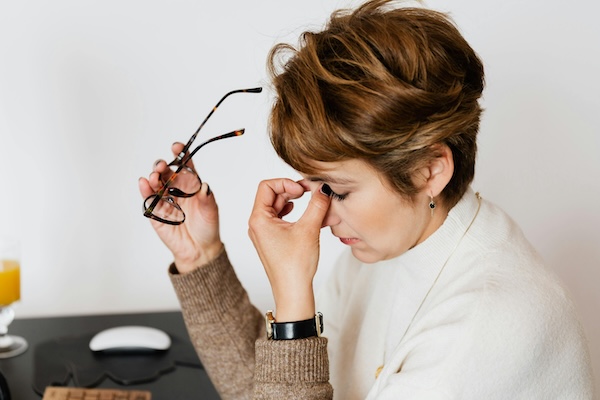Anti-stress glasses: a technological response to the challenges of modernity?

In an increasingly connected world, where stress and eye fatigue are omnipresent, "anti-stress glasses" are emerging as an innovative solution to meet the challenges of modern life. Between fatigue linked to excessive use of screens and unbalanced lifestyles, these devices promise to improve visual and mental well-being. But what exactly are they? Do these new technologies really bring tangible benefits or are they just a fad? Let's dive into the world of anti-stress glasses to better understand this growing trend.
Anti-stress glasses for a time of pressure

Never before have visual and mental demands been so strong. With the omnipresence of screens in our daily lives, the eyes are constantly exposed to artificial blue light, a light that is potentially harmful to eye health in the long term . At the same time, the pace of life has accelerated, creating chronic fatigue, sleep disorders and constant stress. This context has led health and wellness professionals to seek new solutions to help individuals better manage their daily stress and visual disorders. Anti-stress glasses, which combine different technologies such as phototherapy and neurostimulation, are thus positioned as a promising response to modern well-being needs.
Anti-stress glasses must overcome several challenges to convince consumers. First of all, it is a question of demonstrating their real effectiveness. Potential users are often skeptical of new technologies that promise health benefits, especially in a field where the effects are not immediately visible. In addition, these devices must differentiate themselves in a market already saturated with wellness tools, such as meditation apps or traditional light therapy solutions. The glasses must also meet the diverse needs of their target audience, whether they are professionals looking to improve their concentration, travelers battling jet lag, or people suffering from sleep disorders. Added to this are questions of cost and accessibility, as these technologies, often expensive, are not always affordable for the general public.
Different models of anti-stress glasses
Several models of anti-stress glasses are currently competing for consumer interest. Among them, the Re-Timer glasses , which use pulsed green light to adjust the circadian rhythm, are particularly popular among frequent travelers and people suffering from sleep disorders. The Ayo glasses , for their part, rely on blue light combined with a mobile application that offers personalized programs for sleep and energy. The Pegasi 2 glasses also use green light, but focus on simple daily regulation of the sleep-wake cycle. Finally, the Muse headband , which relies on EEG neurostimulation and is not an optical device, is aimed more at lovers of meditation and mental relaxation, thus completing the offer with a purely cognitive approach. These devices do not compete directly, but explore different avenues to meet different needs.
PSiO glasses stand out from other anti-stress glasses due to their multisensory approach that combines photostimulation (use of colored lights pulsed at specific frequencies to influence brain waves, helping to induce states of deep relaxation, concentration or sleep) and audiostimulation (the glasses are equipped with integrated headphones that broadcast binaural sounds, relaxing music or guided meditations to improve relaxation and emotional balance.) Compared to other models, PSiO glasses offer distinct benefits thanks to their combination of technologies. By combining phototherapy and audiostimulation, they offer a holistic approach to stress and anxiety reduction. They offer light and sound programs specifically designed to prepare the brain for sleep and improve sleep quality. Finally, "power naps" sessions for rapid recovery and better concentration are also possible.
Unanswered questions

While anti-stress glasses are promising, they still raise many questions. First, the lack of unanimous scientific validation on the effectiveness of these devices remains a major obstacle. Although some studies show encouraging results, others highlight the lack of tangible evidence regarding their real impact on mental and visual health. In addition, it is essential to understand whether these glasses are really suitable for long-term use or whether they could have adverse effects. Questions of comfort, ergonomics, and public acceptability also remain unanswered.
Finally, beyond their practical usefulness, anti-stress glasses raise the broader question of our relationship with technology in managing our well-being: should we systematically resort to high-tech gadgets to find balance? The answer to this question could well determine the future of these devices on the market.
Anti-stress glasses are part of a broader movement of research into well-being in the digital age, where the need for innovative solutions is increasingly felt. Between proven effectiveness and persistent skepticism , they represent an interesting response to the challenges of modern stress. Their success will depend on their ability to prove their added value, to adapt to the needs of users and to raise the questions that still surround them.


